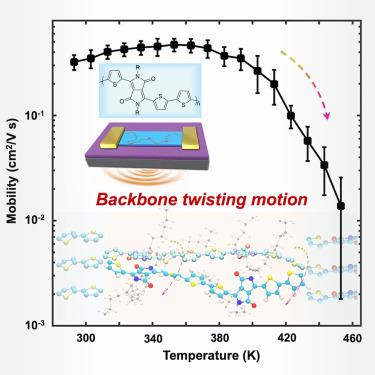通过锁定共轭聚合物的主链扭转来实现高稳定的光电器件在高温下的工作
IF 17.5
1区 材料科学
Q1 MATERIALS SCIENCE, MULTIDISCIPLINARY
引用次数: 0
摘要
有机电子器件在高温下保持稳定性的能力对于光电器件的寿命至关重要。然而,为共轭聚合物实现稳定的光电性能仍然具有根本性的挑战性。本文以二酮吡咯(DPP)基聚合物为模型体系,确定了主链扭转运动是导致给受体共轭聚合物(D-A)光电性能不稳定的主要原因。主链噻吩-环扭转跃迁是导致带隙移位和电荷输运性质改变的原因。噻吩的扭转运动诱导链内电子的定位,导致载流子迁移率降低和光学吸收中显著的蓝移。此外,我们证明了DPP聚合物中的分子内氢键相互作用可以在高温下抑制不希望的主链扭曲,从而确保更稳定的光电性能。我们的工作为高温下器件稳定性的下降提供了基本的见解,并提供了提高器件稳定性的策略。本文章由计算机程序翻译,如有差异,请以英文原文为准。


Approaching highly stable optoelectronic device operation at elevated temperature by locking backbone torsion of conjugated polymers
The ability of organic electronics to maintain stability at elevated temperatures is crucial for the longevity of optoelectronic devices. However, achieving stable optoelectronic properties for conjugated polymers remains fundamentally challenging. Here, we identify backbone twisting motion as the primary reason for the unstable optoelectronic properties of donor-acceptor (D-A) conjugated polymers, using diketopyrrolopyrrole (DPP)-based polymers as a model system. The backbone thiophene-ring twist transition is responsible for shifts in the band gap and alterations in charge transport properties. The twisting motion of the thiophene induces localization of the intrachain electrons, resulting in reduced charge carrier mobility and a significant blue shift in optical absorption. Additionally, we demonstrated that intramolecular hydrogen bonding interaction within DPP polymers can suppress undesired backbone twisting at elevated temperatures, thereby ensuring a more stable optoelectronic property. Our work offers fundamental insights into the decline in device stability at elevated temperatures and a strategy to enhance device stability.
求助全文
通过发布文献求助,成功后即可免费获取论文全文。
去求助
来源期刊

Matter
MATERIALS SCIENCE, MULTIDISCIPLINARY-
CiteScore
26.30
自引率
2.60%
发文量
367
期刊介绍:
Matter, a monthly journal affiliated with Cell, spans the broad field of materials science from nano to macro levels,covering fundamentals to applications. Embracing groundbreaking technologies,it includes full-length research articles,reviews, perspectives,previews, opinions, personnel stories, and general editorial content.
Matter aims to be the primary resource for researchers in academia and industry, inspiring the next generation of materials scientists.
 求助内容:
求助内容: 应助结果提醒方式:
应助结果提醒方式:


